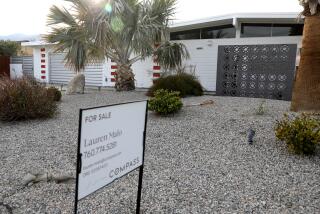It’s a blog blog blog blog world -- and here’s how to join in
- Share via
E-MAIL alone isn’t enough these days to drive a business. Web-savvy real estate agents are blogging, sharing information that gets updated at least once a day and interacting with their readers.
Agents unfamiliar with the idea can get easy-to-understand help from “Realty Blogging: Build Your Brand and Outsmart Your Competition” by Richard Nacht, an expert in e-commerce whose technology company provides blogging services for agents and others in the real estate business. His co-writer, Paul Chaney, a marketing executive at Nacht’s company, Blogging Systems Group, is also a blogging coach.
Like a diary or a journal, a blog -- short for web log -- is a collection of online entries, often a smorgasbord of information and opinion, that the authors recommend should be presented conversationally, with passion and personality, and with everything grammatically correct and spelled right.
The book walks a reader through setting up a blog, including determining intent, tone and core message. It also reviews six blog platforms, among them the popular www.blogger.comand the authors’ own site, www.realtyblogging.com, while pointing out that more than 50 such platforms allow individuals to post to personal websites and get feedback from readers. Some platforms cost nothing, while others charge fees, the book explains. Some are also easier to use than others.
The creator -- called a blogger -- posts entries on a website. The newest addition tops the page, satisfying the hunger of search engines’ desire for the freshest material.
One goal of a blogger should be to top the list of Google search results. The authors suggest ways of doing that. Using case studies, screen grabs and comments from experts, Nacht and Chaney do a good job of demystifying how real estate professionals can use blogging to their business advantage.
The well-organized chapters encourage blogs that showcase expertise while targeting audiences by location, relocation, new homes, luxury market and other marketing niches.
After outlining a convincing argument for starting a blog, the authors provide a detailed roadmap for creating a successful one. Plus, their guide sends a message, especially attractive to the most technologically challenged: It’s not that hard.
Although intended for professionals in the realty business, the book mentions many websites and blogs helpful to consumers who want to buy or sell a house.
Unfortunately, at least one blog referred to in the book has a front page loaded with too much content that’s off the subject -- photos of strange fruit, unusual recipes, someone’s grandparents. The authors encourage adding a bit of fun to allow readers to get to know the blogger and make the site more broadly attractive; however, an onslaught of information that has nothing to do with houses can mislead the visitor into thinking the online address is wrong.
And because a book is more stationary than the Internet, several sites mentioned have been retired or have infrequent posts, a cardinal sin for bloggers.
Overall, “Realty Blogging” offers a timely collection of worthwhile information.
*
gayle.pollard-terry@latimes.com
More to Read
Inside the business of entertainment
The Wide Shot brings you news, analysis and insights on everything from streaming wars to production — and what it all means for the future.
You may occasionally receive promotional content from the Los Angeles Times.










